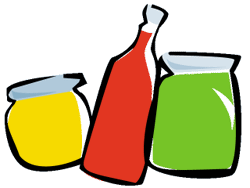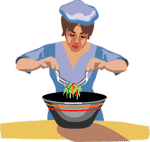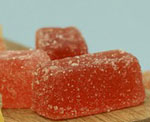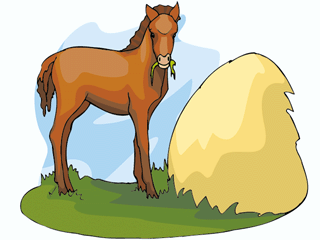Cooking with Vinegar
Best Tips
"So many USEFUL and HEALTHY
vinegar cooking tips!"
Cooking with vinegar fits in well for those who want their food to reflect a natural healthy lifestyle.

Vinegar in any kitchen is a versatile, tasty and healthy ingredient that has endless culinary uses. That's why millions of gallons of all
types of vinegar
are consumed in North America each year.
This amazing liquid is a major ingredient that adds zest to condiments such as tomato ketchup and mayonnaise.
Because of its nutrients and acidic nature, vinegar is used to tenderize meats and
vegetables, to inhibit the growth of bacteria, to make beans less gas producing and to
bring out the flavors in many foods.
Vinegar can also be used as a
salt alternative
for those wishing to reduce the amount table
salt in their diet.
(The average North American diet contains way too much salt from
processed foods.) Using vinegar, food without table salt does not have to be dull and
bland!
As an added benefit for
weight watchers
, vinegar dulls the craving for sweets, contains no
fat and has only 2 calories per tablespoon.
A well-balanced, nutritious diet combined with plenty of fresh air and exercise will help
prevent many of the chronic diseases that are so prevalent in today's world.
Cooking with Vinegar - Kitchen Tips

The following vinegar cooking tips are easy to implement in the kitchen, will improve the
final dish and will often simplify the task at the same time.
Bread
- Adding 1 tablespoon of vinegar for every 2 1/2 cups of flour will help bread to rise. Reduce the amount of water added by the same amount of vinegar added.
- To add luster to the crust of homemade bread, brush the top of the bread with vinegar two minutes before it is done, then finish baking it in the oven.
Buttermilk Substitute
- A great buttermilk substitute can be made by simply adding 1 tablespoon of apple cider vinegar to 1 cup of fresh or canned evaporated milk and letting the mixture stand for 10 minutes or until thick.
Cheese
- Cheese can be kept soft and mold-free by wrapping it in a cloth saturated with vinegar and then keeping it in the refrigerator in an airtight container.
Desserts - Cooking with Vinegar
- You can reduce excess sweetness and enhance the flavor of pies and other desserts by adding a teaspoon of vinegar to the recipe.
- Pie meringue can be made fluffier and more stable by adding 1 teaspoon of vinegar for every 3 egg whites.
- Pie crust can be made flakier by adding 1 tablespoon of vinegar to the recipe.
- Improve the moistness of any cake mix by adding a teaspoon of vinegar.
Eggs
- When making hard boiled eggs add 1 or 2 tablespoons of vinegar to the cooking water to prevent the egg white from leaking out of any shell cracks.
- For poached eggs, vinegar in the poaching water will help the eggs keep their shape.
- If you run out of eggs while baking, you can substitute 1 tablespoon of apple cider vinegar for each egg needed.
Fish
- To make the task of scaling fish easier, first rub the whole fish with vinegar. This will have the added benefit of keeping your hands from smelling fishy.
- When cooking, add a tablespoon of apple cider or white wine vinegar to fried or boiled fish to bring out the flavor and tenderize the flesh.
Fruits
- Clean fruits by soaking them in a solution of vinegar and water (2 tablespoons to a gallon of water) to help remove chemical residues and insects.
- Prevent cut and peeled fruits, such as apples, from browning by placing them into an apple cider vinegar solution (1 tablespoon ACV in the holding water) until they are ready to be used.
Meats
- Tenderize meats by marinating them in a wine vinegar mixed with herbs. This will also enhance the meat flavor. Marinate very tough pieces of meat overnight in the refrigerator.
- Make your own vinegar based bbq sauce that will add flavor and tenderize any barbeque meat.
- To lessen the gamey flavor of wild meat, soak the meat in a vinegar-water solution prior to cooking.
- Improve the flavor and texture of boiled meat by cooking with vinegar. Add a tablespoon of vinegar to the cooking water.
Pasta
- When making pasta, add 1 tablespoon of vinegar to the cooking water to avoid adding salt and to prevent sticking.
Rice
- Cooking with vinegar makes for a fluffier rice. Just add a teaspoon of apple cider or rice vinegar to the cooking water.
Vegetables
- Clean vegetables by soaking them in a solution of vinegar and water (2 tablespoons to a gallon of water) to help remove chemical residues and insects.
- To revive slightly wilted vegetables, add them to a pan of cold water to which 1 tablespoon of apple cider vinegar has been added. This will also help to destroy any undesirable microorganisms.
- When steaming vegetables, add 1 tablespoon of vinegar to the water used for steaming instead of table salt. The veggies will retain their bright colors and will not taste bland.
- To make dried beans less gas producing when eaten, add vinegar to the soaking water and then try cooking with vinegar. Vinegar helps to break down cellulose in any fibrous or stringy vegetables.
- Preserve left over ginger root in vinegar. First peel and slice or grate the ginger then place it in a glass jar, cover it with apple cider or balsamic vinegar and store in the refrigerator.






